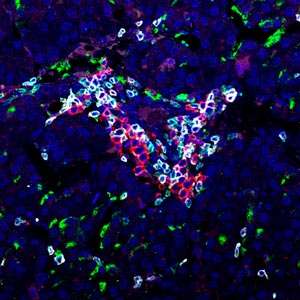A study by A*STAR researchers finds that activated B cells (white & red markers) and T cells (green markers) cluster in close contact within liver cancer tissues. The higher the density of B cells, the better the patient’s chances of survival. Credit: A*STAR Singapore Immunology Network
Immunotherapy—developing treatments by boosting natural immune system responses—holds much potential in the fight against serious diseases. Now, A*STAR researchers have determined how one group of immune cells called tumor-infiltrating B cells (TiBs) can fight liver cancer. Their results could inform future treatments.
Tumor-infiltrating cells, including TiBs and T cells, are white blood cells that have left the bloodstream to enter cancerous tissue. Depending on their type and 'conditioning' they may either promote or control tumor growth. Previous studies have demonstrated a positive correlation between the density of T cells found inside a tumor and a patient's chances of survival. As such, tumor-infiltrating cells are of great interest to scientists developing immunotherapies for cancer.
"The presence of TiBs in tumors has always been controversial, with studies producing conflicting results on whether they play a positive or negative role during cancer," says Alessandra Nardin of the A*STAR Singapore Immunology Network, who worked on the project with an international team of scientists. "We wanted to determine the role of TiBs in liver cancer progression regardless of patients' ethnicities or individual disease triggers."
The team used tissue samples from 112 Asian and European patients with liver cancer. In Asia, there is a relatively high volume of cases of the disease, mainly due to the prevalence of Hepatitis B infection in the region. In Europe, the causes of liver cancer include alcohol consumption and Hepatitis C infection.
Nardin's team traced markers indicating the presence and activation of TiBs and T cells, and examined their distribution inside tumor samples (see image). They found that T cells and TiBs clustered inside tumors, and that those patients with a high density of TiBs had a better chance of survival, regardless of ethnicity or disease triggers. Further investigations using mice models showed that mice with depleted mature TiBs lacked T cell activation and exhibited poor control of tumors.
"The close proximity of TiBs and T cells suggests a functional interaction between them that enhances local immune activation," says Nardin. "TiBs are needed to help T cells control the growth of the tumor and slow cancer progression. We were pleased to discover that TiBs can also act as an independent indicator of improved disease prognosis."
Further work is needed to understand the mechanisms by which TiBs influence the responses and behavior of other immune cells inside tumors.
More information: Marta Garnelo et al. Interaction between tumour-infiltrating B cells and T cells controls the progression of hepatocellular carcinoma, Gut (2015). DOI: 10.1136/gutjnl-2015-310814
Journal information: Gut




















